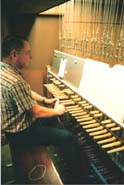

Meeks, Watson & Company has made a specialty of the tonal improvement of existing sets of bells, including peals, chimes and carillons. This has included developing a means for tuning existing chimes made by earlier American bell founders, the improvement of carillon bells of various founders, and the replacement of less than fully successful portions of existing chimes and carillons.
Tonal Analysis
In order to determine our best recommendation for tonal improvement of
an existing chime or carillon, we make a detailed tonal analysis, from
which charts and graphs of the existing bell tuning are made. This
analysis can often be made in person; however, with the advent of digital
recording, highly accurate analyses can be made from such recordings,
and used to plan improvements.
A chime tuning graph showing
tonal readings before tuning
|
A chime tuning graph showing
tonal readings after tuning
|
Bell Tuning
We have tuned with great accuracy many examples of bells, peals and chimes
by all the major earlier American foundries; descriptions of several
of these projects, in many cases involving the addition of bells of
special profile to extend such sets after tuning the old bells, may
be seen in the Featured Projects section of this site. We have also
been called upon to improve the tuning of several carillons by English
and European makers. In our foundry, we have tuning machines currently
capable of tuning work on bells up to 7,000 lbs.; and we have access
to a machine permitting work on bells up to 10 tons.
Tuning a 4,000 lb. Meneely Bell Co. bell
on our larger tuning machine
|
Tuning a 400 lb. old French-made crowned
bell on our medium tuning machine
|
Chime bells on our floor, showing tuning
work completed
|
Bell Recasting
Bells that are cracked, and those that are of such poor shape that tonal
improvement through tuning is impossible, can be recast. Recasting
means that the usable portion of the metal of the old bell will be
used in making a new bell of like size. In many cases, historic inscriptions
can be copied on the recast bell.
A 1,000 lb. bell cracked in a fire awaits
recasting in our foundry
|
A fragment bearing the name of the old Hooper
foundry, part of the bell metal recast into a new bell for First
Parish, Saco, Maine
|
Bell Replacement
In several cases, we have replaced less than successful bells in carillons
with excellent results. Several representative examples of such projects
are described in the Featured Projects section; see particularly the
descriptions of bell replacement work in the carillons at Cranbrook,
Mercersburg, Alfred and Middlebury.
| Some of the new replacement bells cast for the Davis Memorial Carillon, Alfred University, shown in our foundry | |
Meet our Bell Tuner
 |
RICHARD M. WATSON, Partner, bell tuner and carillon designer, a native of Madison, Wisconsin, began to assist at the carillon of The University of Wisconsin, Madison in 1961 while still in high school; he worked with Arthur Bigelow on the enlargement of the U.W. carillon during the summer of 1963, and entering the University in the fall of 1963 majoring in organ he continued as assistant carillonneur all through school; he worked with Prof. Bigelow again in 1966 to prepare the Princeton University carillon for the Congress of the Guild of Carillonneurs in North America that year, and during that Congress played his examination recital and was accepted into Carillonneur membership in this professional organization. In May of 1968, he played the dedication recital on the carillon of Samford University, Birmingham, Alabama, and the following month joined the Samford faculty as Lecturer in Music and University Carillonneur. In addition to his teaching and carillon playing activities at the University, he also conducted acoustical research on bells, and acted as an independent consultant on several carillon projects from 1968-1973. From October, 1973 until June of 1991, Mr. Watson was director of the Cast bell, Carillon and Chime division of The Verdin Company, Cincinnati, Ohio. Prior to his joining that company, all manual carillon consoles and related equipment had been imported from Europe; he started a new department to manufacture all these things, to his own designs. In this capacity he was responsible for the design and construction of many new carillons and the enlargement and/or renovation of many others. Mr. Watson founded Meeks, Watson & Company with Mr. William Meeks in June, 1991, making possible the fulfillment of a longtime desire to return the art of casting and tuning new carillon-quality bells to North America. Since that time, the company has furnished the highest quality American-made bells to all parts of the U. S., Canada and the Caribbean.
 |
Mr. Watson has long made earlier American-cast bells a special study. Beginning in his University teaching days, he researched and developed a method whereby such bells can be tuned to carillon bell standards, and has so tuned a number of chimes and peals. Mr. Watson has appeared in many parts of the U.S. and Canada as a carillon recitalist over the years, including recitals for Congresses of the Guild of Carillonneurs in North America in 1967, 1969, 1971, 1972, 1975, 1980, 1984, 1991 and 1995. He was a featured recitalist for the 50th anniversary celebration of the carillon of the University of Wisconsin in June, 1986, and played at the Springfield (Illinois) carillon festival in June, 1987. He received the Berkeley Medal for outstanding service to the carillon in 1983. He is on the carillon staff of the Emery Memorial Carillon, Mariemont, Ohio. Mr. Watson, in addition to his carillon work, has been practically a lifelong church organist; he is currently organist of St. Paul's Anglican Church, Cincinnati, and music director for the Synods of the Diocese of the Eastern United States, Anglican Province of America.







